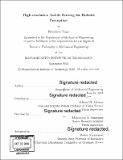| dc.contributor.advisor | Edward H. Adelson and Mandayam A. Srinivasan. | en_US |
| dc.contributor.author | Yuan, Wenzhen. Ph. D. Massachusetts Institute of Technology | en_US |
| dc.contributor.other | Massachusetts Institute of Technology. Department of Mechanical Engineering. | en_US |
| dc.date.accessioned | 2019-02-05T16:02:29Z | |
| dc.date.available | 2019-02-05T16:02:29Z | |
| dc.date.copyright | 2018 | en_US |
| dc.date.issued | 2018 | en_US |
| dc.identifier.uri | http://hdl.handle.net/1721.1/120267 | |
| dc.description | Thesis: Ph. D., Massachusetts Institute of Technology, Department of Mechanical Engineering, 2018. | en_US |
| dc.description | Cataloged from PDF version of thesis. | en_US |
| dc.description | Includes bibliographical references (pages 107-113). | en_US |
| dc.description.abstract | Why is it so difficult for the present-day robots to act intelligently in the real-world environment? A major challenge lies in the lack of adequate tactile sensing technologies. Robots need tactile sensing to understand the physical environment, and detect the contact states during manipulation. A recently developed high-resolution tactile sensor, GelSight, which measures detailed information about the geometry and traction field on the contact surface, shows substantial potential for extending the application of tactile sensing in robotics. The major questions are: (1) What physical information is available from the high-resolution sensor? (2) How can the robot interpret and use this information? This thesis aims at addressing the two questions above. On the one hand, the tactile feedback helps robots to interact better with the environment, i.e., perform better exploration and manipulation. I investigate various techniques for detecting incipient slip and full slip during contact with objects, which helps a robot to grasp them securely. On the other hand, tactile sensing also helps a robot to better understand the physical environment. That can be reflected in estimating the material properties of the surrounding objects. I will present my work on using tactile sensing to estimate the hardness of arbitrary objects, and making a robot autonomously explore the comprehensive properties of common clothing. I also show our work on the unsupervised exploration of latent properties of fabrics through cross-modal learning with vision and touch. | en_US |
| dc.description.statementofresponsibility | by Wenzhen Yuan. | en_US |
| dc.format.extent | 113 pages | en_US |
| dc.language.iso | eng | en_US |
| dc.publisher | Massachusetts Institute of Technology | en_US |
| dc.rights | MIT theses are protected by copyright. They may be viewed, downloaded, or printed from this source but further reproduction or distribution in any format is prohibited without written permission. | en_US |
| dc.rights.uri | http://dspace.mit.edu/handle/1721.1/7582 | en_US |
| dc.subject | Mechanical Engineering. | en_US |
| dc.title | High-resolution tactile sensing for robotic perception | en_US |
| dc.type | Thesis | en_US |
| dc.description.degree | Ph. D. | en_US |
| dc.contributor.department | Massachusetts Institute of Technology. Department of Mechanical Engineering | |
| dc.identifier.oclc | 1083220155 | en_US |
